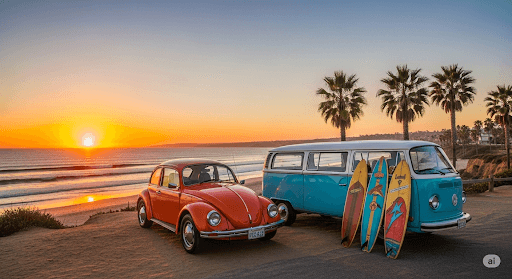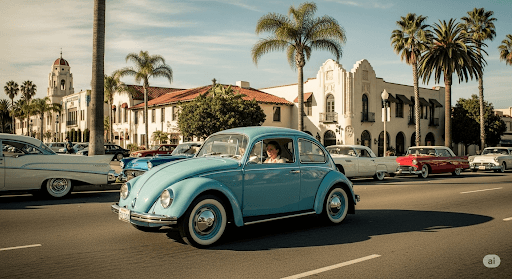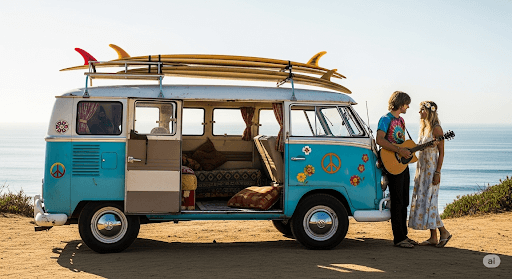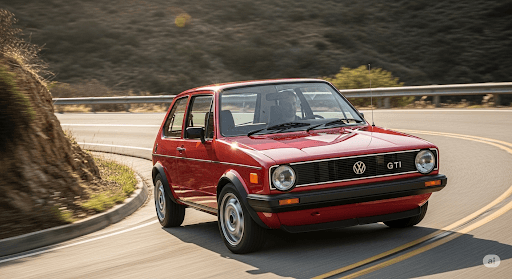
There are cars, and then there are cultural icons. Few brands have managed to capture the human spirit quite like Volkswagen. More than just metal, rubber, and glass, VWs have consistently been characters in the story of our lives—symbols of freedom, adventure, and approachable fun. What is Volkswagen San Diego culture, a city defined by its sun-drenched beaches and laid-back vibe? The legacy of Volkswagen isn’t just visible; it’s a core part of the landscape.
From the unmistakable silhouette of a Beetle cruising through North Park to a classic Type 2 Bus parked by the waves at Tourmaline Surf Park, these vehicles are woven into the fabric of our city. But how did a German “People’s Car” become a beloved icon of Southern California? It’s a story of brilliant engineering, perfect timing, and a spirit that was impossible to resist.
The Unlikely Hero: The Birth of the Beetle
The story starts in the 1930s with a simple but revolutionary idea: a reliable and affordable car for the masses. Designed by Ferdinand Porsche, the Type 1—or Beetle, as it would affectionately become known—was a masterpiece of minimalist engineering.
Its air-cooled, rear-mounted engine was simple to maintain, incredibly durable, and had a distinctive, friendly chatter that would become the soundtrack for generations.

When the Beetle arrived in America, it was the anti-Detroit car. In an age of massive, chrome-laden land yachts, the small, quirky Beetle stood out. Its clever and honest advertising campaigns from the 1960s are now legendary, highlighting its practicality and reliability with wit and charm. It wasn’t about flash; it was about function, and people fell in love with it. In San Diego, it became the perfect city car: easy to park, great on gas, and endlessly charming.
The Icon of Freedom: The Type 2 Bus
If the Beetle was the sensible, fun-loving sibling, the Type 2 “Bus” was the free-spirited adventurer. Introduced in 1950, this humble van, built on the Beetle’s chassis, was a blank canvas for life. It was a work van, a family hauler, and, most famously, the official vehicle of the counter-culture.
For the surf community in San Diego and all along the California coast, the VW Bus was a revelation. You could throw your boards in the back (or on the roof), load up your friends, and chase the swell from Ocean Beach to Swami’s.
It was more than transportation; it was a mobile base camp, a rolling symbol of a life lived on your own terms.

The large windows were perfect for watching the sunset over the Pacific, and its simple mechanics meant that with a little know-how, you could keep it running on the side of the road with a basic toolkit. This self-sufficient spirit cemented the Bus as a legend, and even today, a restored VW Bus is one of the most head-turning sights on PCH.
The Pocket Rocket: How the Golf GTI Invented a Genre

Volkswagen wasn’t just about leisurely cruising. In the 1970s, a group of skunkworks engineers at VW decided to inject some serious performance into their new family hatchback, the Golf (or Rabbit, as it was known in the US). The result was the 1976 Golf GTI.
Lightweight, agile, and powered by a punchy fuel-injected engine, the GTI created an entirely new category of car: the “hot hatch.” It was practical enough for daily errands but an absolute thrill on a winding backcountry road, like those found in East County San Diego. It proved that a fun, performance-oriented car could also be affordable and reliable. The GTI legacy continues today, remaining the benchmark for a car that truly does it all and a favorite among San Diego driving enthusiasts.
The VW Legacy Today in San Diego
Walk around San Diego today, and the VW story is still being written. You’ll see:
- Classic Car Shows: Events like the Big SoCal Euro and local meetups are filled with pristine classic Beetles, buses, and Karmann Ghias, their dedicated owners proudly sharing their history.
- Modern Enthusiasts: The community is just as strong for modern VWs. Tuned GTIs and Golf Rs are a common sight, as are adventure-ready Tiguan and Atlas SUVs loaded with kayaks and mountain bikes.
- The Next Generation: Volkswagen is looking to its past to define its future with the all-electric ID. Buzz—a modern, high-tech reinterpretation of the classic Bus. It’s a vehicle that seems tailor-made for the eco-conscious, adventurous spirit of San Diego.
Keeping the Spirit Alive, Volkswagen San Diego Culture: The Importance of Passionate Care
What do a 1965 Beetle, a 1971 Westfalia camper, and a 2023 Atlas have in common? They are all part of this incredible legacy. And keeping that legacy on the road requires care that goes beyond a simple oil change. It requires a passion for the brand and a deep understanding of what makes these cars special.
The purr of an air-cooled engine, the precise shift of a DSG transmission, the sophisticated electronics in a modern VW—each requires a knowledgeable touch. Preserving these icons, whether classic or contemporary, means entrusting them to people who share the same passion as their owners. It’s about ensuring that future generations in San Diego can still experience the joy of seeing a classic Bus heading for the beach or the thrill of a GTI on a canyon road.
Your Volkswagen is a part of this story. It’s a vehicle with a soul, and it deserves to be cared for by people who get it.
Are you part of the Volkswagen San Diego culture?
At Pacific Automotive, we share your passion. Our team specializes in caring for every model that wears the VW badge, from the air-cooled classics to the latest high-tech models.
Let us help you keep your chapter of the Volkswagen San Diego story going strong.
